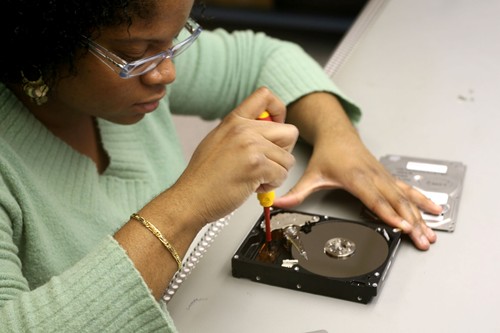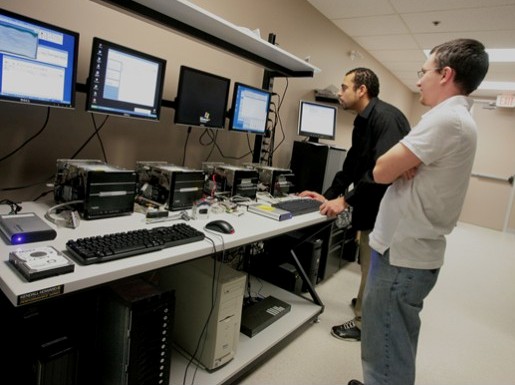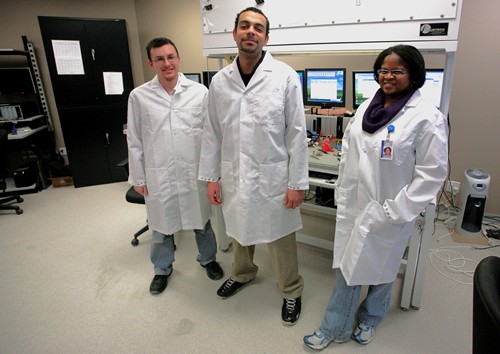In terms of staff count, Ontrack Data Recovery is a small outfit, no question about it.
And yet, this five-employee shop — essentially the entire Canadian operations of Kroll Ontrack Inc. a global data recovery firm headquartered in Minneapolis — has achieved success far greater than its size would warrant.
Each year it recovers valuable, even critical, data for anywhere between 1,500 to 2,000 customers across the country — a track record it has sustained since it opened its doors in Toronto five years ago. (Prior to that, Canadian customers were serviced from Kroll Ontrack’s U.S. offices for around 20 years).
VIDEO – Staying OnTrack with Data Recovery
Ontrack Data Recovery’s customers include small and mid-sized businesses as well as consumers, and recovered items run the gamut – all the way from computer hard drives, and thumb drives to MicroSD flash cards, and multi-disc arrays – any device capable of holding data, in fact.
RELATED ARTICLES
Data recovery firm suggests using courier to ship damaged drives
Four ways SMBs can prevent data loss without breaking the bank
So what’s behind this small outfit’s impressive accomplishments? How does the five-member team handle the varied data recovery needs of so many customers? (The firm’s staff consists of an office manager, a couple of cleanroom engineers, an engineering service technician, and a person dedicated to building the business and partnership accounts).
The employees cite five success drivers: the right skills and expertise, a streamlined workflow, the ability to draw on the tools and resources of Kroll Ontrack’s worldwide office network, and a total commitment to customer service.
The last factor, they say, includes a commitment to getting the job done, regardless of the difficulties and time involved (working on weekends and through the night is not unusual) and meaningful interaction with customers before, during, and after the data recovery process.
“Choice” is a key element of this interaction, John Riddell, operations manager at Ontrack Data Recovery told ITBusiness.ca. Where possible, he said, this extends to the recovery method.
“When a customer contacts our Call Centre, we go through a series of questions to determine the nature of the problem, and the most appropriate strategy.” A couple of these don’t even require the product to be brought in or shipped to the Ontrack lab.

For instance, using a proprietary remote data recovery application — with the customer’s permission — the Ontrack technician may access their home computer (if it’s still functional).
“We would then run our diagnostics tools on their machine, and see if we can recover it remotely,” Riddell said. “If we succeed, we back the data on to media sitting at home with them.”
He emphasized that such remote recovery can only be done with the customer’s express permission and participation.
“We make a utility available to them off our Web site. They need to download that on to a functional drive for us to be able to dial in and take control. So we have no way of getting into their machine until they allow us.”
Another option, he said, it to enable the customer to recover the data themselves.
“We have series of software packages they can download. We offer a free trial on our Web site that enables them to see what data is recoverable. They then have the option to purchase that software and complete the recovery process.”
Hardware problems are at the root of most jobs that need to be handled at Ontrack’s Toronto lab. Here again the clientele is varied, Riddell noted. “Roughly half of the physical recoveries in our lab are products from small and mid-sized businesses, and half from home users.”
Customers can track the progress of their jobs real-time through Ontrack Online and Ontrack VerFile reports, which show them the condition of their recoverable files. They can then decide whether to proceed with the data recovery service or not.
Diagnostics is a vital aspect of the process, noted Anick Silencieux, engineering cleanroom supervisor, Ontrack Data Recovery.
She said a variety of tools enable the firm’s engineers to read the drive and image files better and faster, to target critical files, and provide a detailed file report to the customer of which files can be recovered.
The data recovery process itself, Silencieux said, could take anywhere from 10 minutes to a few days, depending on how severe the problem is. “The customer may have damaged the drive by dropping it, or the issue could be an internal mechanical or electronic failure – which is the case 90 per cent of the time.”
Corrupt hard drive sectors or bad configuration may also cause data loss, and to rectify these problems Ontrack also has a range of proprietary software tools, she said.
If a part is required, which the Canadian lab doesn’t have, it can tap into the shared inventory of Kroll’s worldwide offices, said Silencieux. “We have a very comprehensive database of all our parts. So if we don’t have something in-house, chances are one of our global offices will have it, and ship it to us.”
But shared global resources extend beyond access to physical parts and components.
Kroll has 18 cleanrooms across the world, with 3,000 employees, and about 200 engineers just dedicated to recovering data, Riddell noted. “We can tap into the expertise of any one of them if there’s a specific problem we can’t resolve in-house.”
And those rare cases where even this doesn’t resolve the problem, the firm could get Kroll’s R&D team involved.
“Their research helps us to learn something new, which may help our engineers across the world in similar jobs,” Silencieux noted. “The most gratifying aspect of this process is knowing we’ve helped advance the pool of knowledge relating to a particular aspect of data recovery.”

Kroll R&D was in the spotlight recently for improvements it devised to data recovery capabilities for Apple’s Mac systems by developing a Recovery Positioning System.
The system prioritizes the recovery strategy based on the customer’s most important needs. It can also locate specific information on used areas of the drive, as well as critical file types. This “improves the quality and turnaround time of the recovery,” said Jim Reinhart, vice-president of product development at Kroll Ontrack in a statement.
Silencieux said recovering products when the failure is intermittent can be a real challenge. “These are hard to troubleshoot because the problem doesn’t occur all the time.”
However, recovering data day in and day out (and quite often at night as well) gives you a mind set that helps you meet even the toughest recovery challenges head on, so long as you have certain crucial skills, proper training, and the right aptitude and attitude, she said.
Silencieux, who has a background in electrical engineering, says “attention to detail” is a critical quality for a data recovery expert. “You also have to be adept at troubleshooting computers. And general love for technology is very important coupled with a desire to always learn new things.”
Her colleague, Jason McKay, associate cleanroom engineer at Ontrack Data Recovery, said media damage – either due to human error or other factors – is another big obstacle to data recovery.
“We sometimes recover drives that were previously opened by other data recovery companies. At times these have fingerprints or the wrong parts. That takes a little longer to troubleshoot, because it’s not always easy to tell what’s original and what was added in.”
Optimizing workflow
Wrapped around the data recovery process is a streamlined workflow that eliminates delays and enables Ontrack Canada’s small team to handle its “jobs” in the quickest time possible time.
When a piece of media comes in, David Baker, the team’s engineering service technician does an initial diagnosis to determine if the problem is hardware or software related.

“If it’s a mechanical problem I pass it on to the cleanroom, if it’s software related we’ll use our own tools to get it read and pass it on to the lab,” Baker said. “Once the job is done, we verify the data to make sure it is the customer’s and then put it on an external drive, and send it back to the customer.”
The external drive includes instructions to make it easy for customers to put it back on to their computers.
“We’ll do a follow up call a couple of days after it’s sent back,” Riddell said. “We also include the information on their data services representative that dealt with them throughout their recovery process. We also have a tech support toll free number that they can call if they have any problems.”
Joaquim Menezes is Editor at Large, ITBusiness.ca. Follow him on Twitter, and join the IT Business Facebook Page.




